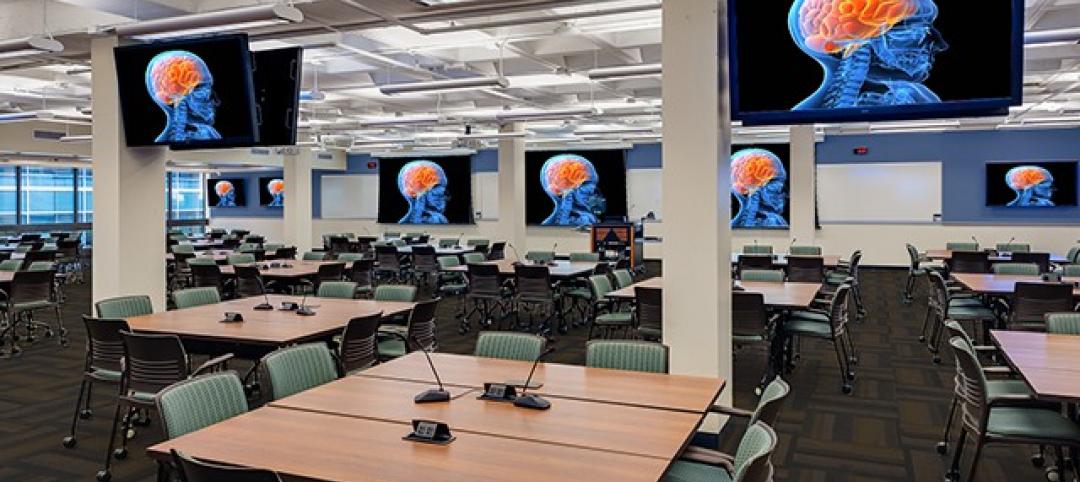Window and door systems need to perform. Period. Over and over again, respondents to Building Design+Construction’s annual window and door survey overwhelmingly
reported that performance, weather resistance, durability, and quality were key reasons a particular window or door was specified.
Respondents also offered opinions on materials choices (aluminum is tops for windows, wood for doors), glazing options (no clear favorites), daylighting (somewhat
of a concern), and use of BIM in window and door selection (not a concern).
Here’s what a representative sample of your peers told us about why and how they choose the windows and doors they use.
(Download a PDF of the full survey report below)
What Factors Influence Selection?
• Respondents overwhelmingly said the top factors influencing their window/window system choices are energy/thermal performance (87%), durability/reliability (73%), and weather resistance (70%). Aesthetics ranked high as well, with 62% of respondents listing it as an important factor. Tax credits, rebates, and other incentives proved not to be significant purchasing factors.
• Performance is also a significant factor for door/door system choices. The top factors influencing door/door system choices—energy/thermal performance (76%), durability/reliability (75%), and weather resistance (65%)—are the same ones respondents cited as influencing their window decisions. Here, aesthetics ranked slightly higher than it did for windows, with 64% of respondents saying it’s a significant influencer. The majority of respondents (58%) choose the door hardware for most projects.
• When it comes to interior door selection, aesthetics ranked highest, with 72% of respondents saying it was their main influence. Other top factors in selection: performance (67%), initial costs (54%), and acoustical performance (43%).
• When asked about specific concerns with window and door products overall, quality/performance was at the top, with 58% of respondents voting it their gravest concern. Second on their list: leaks or failures—very closely related to quality and performance—with 51% expressing concern. Forty-four percent of respondents listed government requirements as their least important concern with window and door projects.
• Several respondents who provided written feedback noted concern about proper installation and the skill levels of contractors who install windows or doors. However, when ranking concerns, only 28% listed installation problems as a major concern.
• The types of projects our respondents undertook greatly influenced window and door selection. Office buildings (56%) and multifamily housing (46%) were most often cited as the project types respondents undertook during the past couple of years. Retail/entertainment (32%) and government/military (29%) projects also ranked high.
Product Selection: A Mix of Materials
• Aluminum (51%) and wood (40%) are the window framing materials most often specified by respondents. Aluminum-clad wood (35%) and vinyl-clad wood (33%) also ranked high as framing materials.
• Wood doors are a favorite for 72% of respondents, while steel doors are also popular, with 58% of respondents specifying them. Aluminum doors and glass doors also fared well, with 39% of respondents specifying aluminum and 38% specifying glass.
• Standard window and door products are an overwhelming favorite of respondents, with 73% saying they specify standard units compared with only 27% who specify custom units.
• Daylighting does play a role in our respondents’ window selections, with 59% saying it was an important or significant factor, while 41% said daylighting was only an average-rated factor to not being a factor at all.
• Although code requirements are a factor in any product decision, when it comes to daylighting, 68% of respondents said code requirements are an important or very important factor. Only 13% said that codes almost never or never factor into daylighting decisions.
Product Types
• When it came to glazing types used in projects during the last couple of years, no particular type stood out above others. Respondents indicated that each specialty type—fire-rated/safety, impact-resistant, laminated, and tinted—were used equally, and in each case in just a few projects.
• One relatively new glazing type, electrochromic glass, was used extensively by only 1% of respondents; 83% reported no use of the technology. Similarly, only 2% reported extensive use of movable glass wall systems, while 72% reported never having used them. Clearly, new technologies like these take some time to gain adoption by AEC professionals.
• Operable windows were used in a significant number of projects, according to respondents who used them extensively (47%), in at least half their projects (21%), or in a few projects (22%). Only 10% reported no use of operable windows.
• Half the respondents reported using skylights and roof windows in just a few projects; 25% reported never having used them. Only 10% reported using them extensively, and 15% reported using them in an average number of projects.
BIM Usage Not Quite a Factor
• Building information modeling doesn’t currently play a major role in our respondents’ window- and door-related projects, with 64% saying they haven’t used BIM in this capacity. Only 11% report extensive use of BIM in making window and door selections. It might be a few more years before BIM usage cranks up for window and door projects because only 15% of respondents expect to use BIM in this capacity in the next couple years. Almost half (48%) said they don’t expect to use BIM in this capacity at all over the next couple years.
SURVEY METHODOLGY
The survey was emailed to a representative sample of BD+C’s subscriber list. No incentive was offered; 451 qualified returns were obtained. The majority of responses (45%) came from architects and designers, a group that represents half of BD+C’s subscriber base. However, respondents were spread across the professions, and included 22% from contractors and 12% from the engineering fields.
Related Stories
| Aug 18, 2014
SPARK’s newly unveiled mixed-use development references China's flowing hillscape
Architecture firm SPARK recently finished a design for a new development in Shenzhen. The 770,700 square-foot mixed-use structure's design mimics the hilly landscape of the site's locale.
| Aug 18, 2014
Seaside luxury: Arquitectonica, Melo Group introduce Aria on the Bay condo tower in Miami
Melo Group has launched sales for Aria on the Bay, its new 647-unit luxury condominium in Miami. The bayfront condo will overlook Margaret Pace Park, Biscayne Bay and the Miami Beach skyline.
Sponsored | | Aug 16, 2014
Fire-rated framing system makes the grade at Johnson & Wales University Center
The precision engineering of TGP’s Fireframes Aluminum Series creates narrow profiles and crisp sightlines at Johnson & Wales University Center for Physician Assistant Studies
| Aug 16, 2014
Decoupling the professional services firm
Business consultant Tim Williams authored a recent LinkedIn post that highlights the emerging trend among professional services firms toward “decoupling,” or consciously separating the high-value services that are scarce from the low-value services that are plentiful. SPONSORED CONTENT
| Aug 16, 2014
The science of learning: Designing the STEM learning facilities of the future
New technology and changing pedagogies are influencing how to best teach a generation of learners who have never known a world without smartphones or tablets, writes HOK's Kimberly Robidoux.
| Aug 16, 2014
Calatrava in hot water again? Famed architect charged to appear in court in Spanish construction case
The Valencia High Court has requested documents detailing how Calatrava was hired in private, without any publicity, for a convention center project in Castellon. For contracts over a certain minimum value, that is illegal in Spain.
| Aug 15, 2014
First look: RMJM’s 'jumping fish' tower design for the Chinese Riviera
The tower's fish-jumping gesture is meant to symbolize the prosperity and rapid transformation of Zhuhai, China.
| Aug 15, 2014
Periscope structure gives public toilet an unobstructed sea view
Polish architect Adam Wiercinski designs a public toilet with a periscope mechanism that gives visitors unobstructed views of the sea.
| Aug 14, 2014
8 do's and don'ts for completing an HVAC life cycle cost assessment
There are many hurdles to overcome when completing a life cycle cost assessment. RMF Engineering’s Seth Spangler offers some words of advice regarding LCCAs.
| Aug 14, 2014
Life cycle cost analysis using energy modeling
A life cycle cost analysis helps a school district decide which HVAC system to use in $198 million worth of future building projects.

















